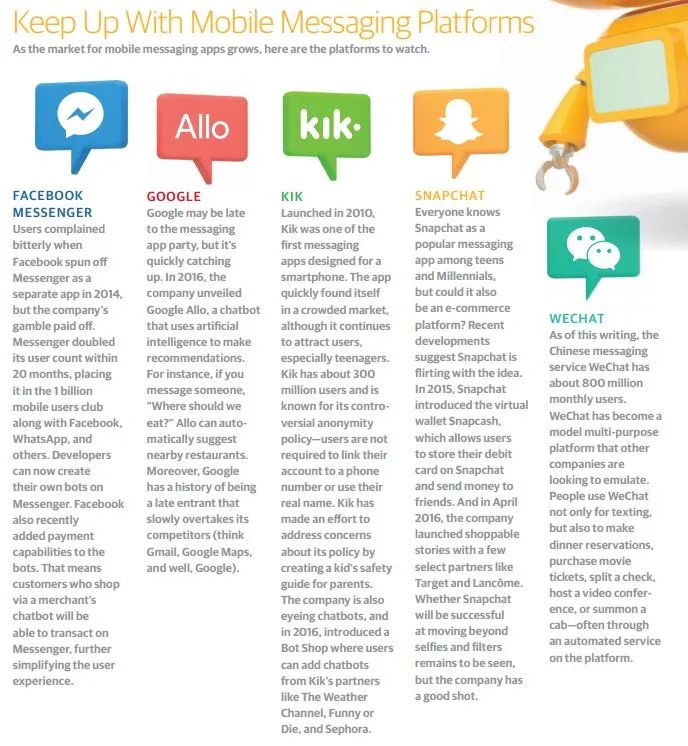Studies show that consumers are experiencing mobile app fatigue. They’re just not that into them anymore, with a few exceptions. One of those exceptions is mobile messaging apps—consumers are spending more and more time on messaging apps like Facebook Messenger, Snapchat, WeChat, and others (see sidebar). Naturally, companies want to be part of these conversations. And increasingly, they’re using chatbots to do it.
Chatbots on messaging apps allow brands to personally engage at scale with people on the platforms where they’re already spending a lot of time. They are computer programs that use machine learning to pick up on conversation patterns and mimic human conversation when reacting to spoken or written prompts. Chatbots can be connected to a variety of data sources via APIs to deliver information and services on demand, from weather forecasts to order requests.
The potential for chatbots to enhance customer experiences has companies betting on them as a new way of interacting with consumers, but early examples show that chatbots still have a lot to learn.
Messaging gets personal
The initial appeal of messaging apps was that they offered people the ability to communicate via mobile for free, unlike SMS text messages that are billed per text, notes Jason I. Hong, an associate professor in the School of Computer Science at Carnegie Mellon University, who is studying human-computer interactions. Since then, messaging apps “have expanded to have a lot of cool features for connecting people,” Hong says. “These include games, animated GIFs, multimedia content, video conferencing, asynchronous voice messages, and sharing one’s current location—along with maps.”
Indeed, “the most important driver [of messaging apps] is the ability to multitask,” agrees Kartik Hosanagar, a professor at the Wharton School of the University of Pennsylvania, whose research focuses on the digital economy. WeChat, a Chinese mobile messaging app, for example, makes it easy for users to manage multiple tasks besides texting. WeChat’s platform is simple enough that children can use it to communicate with their parents and adults can use it to shop online, pay bills, order a taxi, and book medical appointments, all without leaving the WeChat platform.
Most people use chat apps for one-on-one conversations. Therefore, “the expectation of a more personalized and more human form of interaction means brands can’t have a one-size-fits-all type of approach to messaging,” Hosanagar says. But hiring employees to communicate with customers is expensive. In addition, mobile messaging is considered highly personal and users do not appreciate brands littering their screens with advertising.
Thanks to advances in technology, chatbots offer a potential solution. Chatbots that can reasonably mimic humans allow brands to more efficiently engage consumers on messaging platforms. However, “there needs to be a clear value proposition beyond the chatbot sending ads to you,” Hong points out. “A good possibility might be online help for questions customers might have.”
Increasingly, organizations are doing just that. The White House Facebook page has a chatbot that guides people through the process of sending a message to the president. Sephora’s Reservation Assistant lets users book or edit a makeover appointment through Facebook Messenger. And the New York Times created a Facebook Messenger bot to cover the U.S. presidential election. The bot combined automated updates with articles from political reporter Nicholas Confessore. Users could also ask the bot for the Times’ projections for each state and for results of national polls.
Chatbots are particularly useful for answering routine questions or questions with straightforward answers. “Instead of waiting for 30 minutes for a customer support person and then being rerouted to another one, it is so much more appealing for a customer to post their questions on messaging platforms [and get a quick response],” Hosanagar says. “For brands, most inquiries are routine ones like return policy, order history, etc., that can be answered by A.I.-powered chatbots in some cases, brands can also use messaging to share information about products and help customers with the discovery process.”
At the same time, chatbots are far from perfect. Most chatbots today can only recognize keywords and get thrown off by questions that aren’t pre-programmed. And in some cases, it’s faster to perform the task yourself, such as locating an item on a website, rather than feed information to the chatbot.
A smarter strategy is to combine chatbots with human associates who can provide advanced support. On WeChat, for instance, users may start with an automated conversation, but if it is unable to fulfill the customer’s request, it will pass the customer to a human associate associated with the account. A hybrid approach thereby allows associates to focus on more complicated questions instead of answering routine questions over and over. Allocating resources this way allows customers to receive faster and more efficient support and can help boost customer satisfaction.
What’s next: Smart messaging
Right now, chatbots essentially perform the same services as an IVR system on a messaging platform. But analysts predict chatbots and messaging apps will soon be able to perform far more advanced services that deepen relationships with customers.
“In the next three to five years, messaging apps will rise in tandem with adjacent technologies,” according to a recent Forrester Research report titled, “The Future of Messaging Apps.” “Technology innovation in natural language processing, semantic search, image and voice recognition, and especially A.I. will progressively blur the lines between messaging apps, bots, and voice-based assistants,” the authors write.
In other words, messaging apps will soon leverage more data sources and technologies to deliver smarter, contextually driven services on branded accounts. “I think a big one will be improving effectiveness of communication,” Hong says. “This might include using sensor data to let people know you got home OK, or that you’re driving and can’t chat right now.”
The race is on among companies like Apple, Google, Facebook, and Microsoft to build more powerful messaging apps. “We think we’re on the cusp of messaging version two,” Nick Fox, who oversees communication products at Google, recently told Wired. “Messaging is going from being just about sending text to really expressing yourself much more fully, much more broadly, much more naturally. And then to getting stuff done in your chats.”
The first phase of the messaging/chat app revolution was dedicated to growth and driving adoption rates. Companies are beginning to enter the second phase, which is about building out services and monetizing a chat app’s user base. But this phase will likely be more challenging as developers try to figure out which chatbots create the most engagement.
The downside to experimentation is that the market for chatbots will also be glutted with bots that offer little value, just as we’ve seen happen with the app economy. Smarter developers will have learned their lesson and focus on chatbots that are simple to use and provide value.
After all, developers have plenty of incentives to build better bots that allow companies to deliver more convenient and personalized services. Imagine the demand for a tool that allows customers to schedule a service repair via chat and receive alerts when the repair truck is on its way (or running late). Or a virtual assistant that tracks traffic conditions and tells you what time to leave in order to reach the airport or a meeting on time. People will be more likely to adopt automated tools that allow them to focus on the tasks that need a human touch.


















